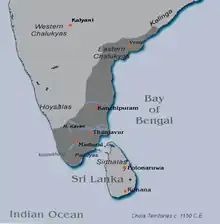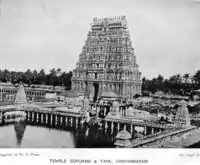| Kulothunga II | |
|---|---|
| Rajakesarivarman Tirunirru Chola | |
 Sculpture of Kulothunga II at Airavatesvara Temple | |
| Chola Emperor | |
| Reign | c. 1133 CE – c. 1150 CE |
| Predecessor | Vikrama Chola |
| Successor | Rajaraja II |
| Born | Gangaikonda Cholapuram, Chola Empire (modern day Jayankondam, Tamil Nadu, India) |
| Died | 1150 CE Chidambaram, Chola Empire (modern day Tamil Nadu, India) |
| Queen | Tyaagavalli Mukkokilan |
| Issue | Rajaraja Chola II |
| House | Chalukya Cholas |
| Dynasty | Chola |
| Father | Vikrama Chola |
| Mother | Mukkōkilānadigal |
| Religion | Hinduism |
| Chola Kings and Emperors |
|---|
| Interregnum (c. 200 – c. 848 CE) |
| Related |
Kulothunga II (died 1150 CE) was a Chola Emperor from 1133 CE to 1150 CE. He succeeded Vikrama Chola to the throne in 1135 CE. Vikrama Chola made Kulothunga his heir apparent and coregent in 1133 CE, so the inscriptions of Kulothunga II count his reign from 1133 CE.[1] According to historians Nilakanta Sastri and T.N Subramanian, Kulottunga Chola II was not the son of Vikrama Chola and they have suggested that there was a break in the line of succession.[2]
Personal life and family
Kulothunga II preferred to live in Chidambaram rather than the royal capital at Gangaikonda Cholapuram. Of the various titles he had, Anapaaya was perhaps his favourite. It is found in his inscriptions as well in the poetic tribute Kulothunga Cholan Ula.[3] He was also called Tirunirruchola.[4]
Kulothunga II was succeeded by Rajaraja Chola II in 1150 CE.
Extent of Empire

The extent of empire as inherited from his predecessor Vikrama Chola was well maintained. The Western Chalukya kingdom was overthrown by the Yadava chiefs of Devagiri and Hoysalas of Dwarasamudra during this period. Kulottunga II took advantage of the internal skirmishes and rebellions in the Kannada and Chalukya country to establish his hold over Vengi and Eastern Chalukya territories. Gonka II of the Velanadu Choda family who ruled over northern part of Vengi acknowledged his supremacy. Similarly the Kadapa-Nellore chief, Madurantaka Pottapi Choda, son of Betta I and Buddhavarman III of the Kondavidu branch and his son Mandaya II also acknowledged the king's authority in the Andhra country.[5]
Patron of Chidambaram
Chidambaram is one of those five places where Chola princes were invested with the crown. Kulothunga was a great devotee of the Chidambaram Temple to Lord Shiva in that city, and he celebrated his coronation there. An inscription of the emperor from Tirumanikuli hails this event and states that the emperor celebrated his coronation so as to add lustre to the city of Tillai (Chidambaram).[6]
He also financed an elaborate renovation of the temple as described in the poem Kulothunga Cholan Ula. It is possible that this renovation work was a continuation of work started by Vikrama Chola. Kulottunga II is credited with gilding the Perambalam of the Nataraja Temple, Chidambaram with gold. He is also said to have constructed its gopurams and the Thousand Pillared Hall.[7][8]

Literature
Kulottunga Chola II's reign was marked by literary activity as evidenced by the works of Sekkizhar and Ottakoothar.[9] Sekkizhar composed the Periyapuranam, a religious treatise on Shaivism during his reign.[10] The Kulottunga Cholan Ula and the Kulottunga Cholan Pillai Tamil, a work dealing with the emperor's childhood were authored by Ottakoothar in honor of the emperor.[11]
Persecution of Vaishnavas
Some scholars identify Kulothunga II with Krimikanta Chola or worm-necked Chola so called as he is said to have suffered from cancer of the throat or neck. The latter finds mention in the Vaishnava Guruparampara and is said to have been a strong opponent of the Vaishnavas. The work Parpannamritam (17th century) refers to the Chola king called Krimikanta who is said to have removed the Govindaraja idol from the Chidambaram Nataraja temple.[12] The Kulothunga Cholan Ula states that during the reign of Kulottunga II, God Vishnu was sent back to his original abode, that is the sea.[13] However, according to "Koil Olugu" (temple records) of the Srirangam temple, Kulottunga Chola was the son of Krimikanta Chola. The former, unlike his father, is said to have been a repentant son who supported Vaishnavism.[14][15] Ramanuja is said to have made Kulottunga II as a disciple of his nephew, Dasarathi. The king then granted the management of the Ranganathaswamy temple to Dasarathi and his descendants as per the wish of Ramanuja.[16][17]
Inscriptions
The Tyagarajaswami temple in Tiruvarur contains an inscription of the emperor in which he styles himself as Anapaaya and a bee at the lotus feet of Natesa at Chidambaram.[3] As per the Muchukundasahasranamam, Anapaaya Mahipaala is another name of the deity Thyagaraja of Thiruvarur.[18]
In popular culture
In the film Dasavathaaram (2008), actor Napoleon plays the role of Kulothunga Chola II.
Notes
- ↑ K.V. Raman. Sri Varadarajaswami Temple, Kanchi: A Study of Its History, Art and Architecture. Abhinav Publications, 2003 - 206 pages. p. 15.
- ↑ Rajeshwari Ghose (1996). The Tyagaraja Cult in Tamilnadu: A Study in Conflict and Accommodation. Motilal Banarsidass Publishers Private Limited. pp. 323–324.
- 1 2 P. V. Jagadisa Ayyar. South Indian Shrines: Illustrated. Asian Educational Services, 1982 - Hindu shrines - 638 pages. p. 216.
- ↑ Vidya Dehejia. Slaves of the Lord: The Path of the Tamil Saints. Munshiram Manoharlal, 1988 - Art - 206 pages. p. 19.
- ↑ Government Of Madras Staff, Government of Madras. Gazetteer of the Nellore District: Brought Upto 1938. Asian Educational Services, 1942 - Nellore (India : District) - 378 pages. p. 43.
- ↑ S. R. Balasubrahmanyam; B. Natarajan; Balasubrahmanyan Ramachandran. Later Chola Temples: Kulottunga I to Rajendra III (A.D. 1070-1280), Parts 1070-1280. Mudgala Trust, 1979 - Architecture - 470 pages. p. 102.
- ↑ Archaeological Survey of India, India. Dept. of Archaeology. Epigraphia Indica, Volume 27, Volumes 13-14 of [Reports]: New imperial series, India Archaeological Survey. Manager of Publications, 1985. p. 96.
- ↑ Madras (India : State). Madras District Gazetteers, Volume 1. Superintendent, Government Press, 1962. p. 55.
- ↑ Sailendra Nath Sen. Ancient Indian History and Civilization. New Age International, 1999 - India - 668 pages. p. 486.
- ↑ Karen Pechilis Prentiss. The Embodiment of Bhakti. Oxford University Press, 06-Jan-2000 - Religion - 288 pages. p. 117.
- ↑ Prema Kasturi; Chithra Madhavan. South India heritage: an introduction. East West Books (Madras), 2007 - History - 616 pages. p. 294.
- ↑ B. Natarajan; Balasubrahmanyan Ramachandran. Tillai and Nataraja. Mudgala Trust, 1994 - Chidambaram (India) - 632 pages. p. 108.
- ↑ Three great Acharyas: Sankara, Ramanuja, and Madhwa: critical sketches of their life and times: an exposition of their philosophical systems. G. A. Natesan, 1947. p. 126.
- ↑ V. N. Hari Rao. Kōil Ol̤ugu: The Chronicle of the Srirangam Temple with Historical Notes. Rochouse, 1961. p. 87.
- ↑ Mu Kōvintacāmi. A Survey of the Sources for the History of Tamil Literature. Annamalai University, 1977. p. 161.
- ↑ C. R. Sreenivasa Ayyangar. The Life and Teachings of Sri Ramanujacharya. R. Venkateshwar, 1908. p. 239.
- ↑ Colin Mackenzie. T. V. Mahalingam (ed.). Mackenzie manuscripts; summaries of the historical manuscripts in the Mackenzie collection, Volume 1. University of Madras, 1972. p. 14.
- ↑ Rajeshwari Ghose (1996). The Tyagaraja Cult in Tamilnadu: A Study in Conflict and Accommodation. Motilal Banarsidass Publishers Private Limited. p. 331.
References
- Nilakanta Sastri, K.A. (1935). The CōĻas, University of Madras, Madras (Reprinted 1984).
- Nilakanta Sastri, K.A. (1955). A History of South India, OUP, New Delhi (Reprinted 2002).